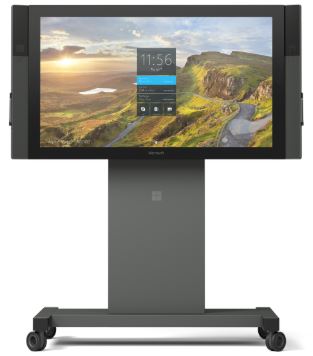Interactive Whiteboard Screen
The first interactive whiteboard was released in 1991, and as recently as a few years ago, it appeared that the technology was cementing itself as a permanent mainstay in the classroom — helping teachers to embrace technology and promoting 21st Century skills in students. A number of districts around the country placed the tools in all of their classrooms, and teacher professional development programs were reshaped around the technology.
Fast-forward to today, and the market has shifted. While a number of schools continue to use interactive whiteboards, many are transitioned to interactive digital displays—which look more like flat-panel TVs or jumbo-sized tablets than dry erase boards—as they fund new purchases. Several interactive whiteboard makers have either gone out of business or shifted their own strategies, and even SMART Technologies (whose SMART Boards came to be synonymous with interactive whiteboards) has embraced interactive digital displays.
“If you go to a major trade show, you’ll be hard-pressed to find interactive whiteboards anymore,” says Stephen Yao, head of product marketing for SMART Technologies. “If you look at price points 10 years ago, if you were to buy a large touchscreen, it would have set you back $20,000 or $30,000 for a 78- or 80-inch display. Today, you might be able to get a 65-inch display for under $3,000. It’s a stark difference.”
The good news for educators: This doesn’t really matter. It’s true that there are some advantages to digital displays. For one, they can be moved easily without having to recalibrate a projector. They don’t require replacement bulbs and their screens are sometimes easier to see in direct light than older interactive whiteboard displays. But, from an instructional standpoint, digital displays and traditional interactive whiteboards are interchangeable.

“It’s the same approach,” says Yao. “All our displays come with pens that you can use to write on the screen. If you misplace the pen, you can use your finger to write. And for students who need certain accommodations, you can you use third-party objects, like a tennis ball.”
Anything that can be done on a computer monitor can be replicated on an interactive whiteboard or interactive digital display. A teacher can create engaging lessons that focus on one task, such as a matching activity where students use either their fingers or a pen to match items. Another teacher might integrate multiple items into a lesson, such as websites, photos and music, that students can interact with, respond to verbally or even write comments on the board itself. Image size and placement can change with a simple touch to the screen. This technology makes the one-computer classroom a workable instructional model. Imagine taking a class on a photo safari to Africa complete with embedded videos, animal sounds and mapping software.
Research has repeatedly demonstrated that students learn better when they are fully engaged and that multisensory, hands-on learning is the best way to engage them. Interactive whiteboards facilitate multisensory learning whether it is a collaboration exercise for math problem solving or a Google Earth tour of the Amazon rainforest.
Starboard FX-89WE2 - Touch Sensitive Interactive Whiteboard; 89' Diagonal, 16:10 Aspect Ratio Screen Size: 89 IN Video Resolution: N/A. TURN ANY SCREEN TO A DIGITAL WHITEBOARD GoTouch turns any screen that you already have (TV, monitor, projector screen) into a digital whiteboard and connects to your PCs, smartphones or Mac. COST EFFECTIVE Save money by using an existing TV, monitor, or projector screen and GoTouch will transform it into an interactive whiteboard. The Doceri screen is divided into two, the bottom screen which serves as the control remote and the top screen which is used for displaying the section of the projected content. Conclusion Interactive whiteboards are presently a central piece of learning foundations and organizations.

Classroom applications for using interactive whiteboards and digital displays include:
- Multimedia lessons and presentations including audio and video
- Collaborative problem solving
- Showcasing student projects and presentations
- Virtual field trips
- Recorded lessons that can be used by substitute teachers
- Documentation of student achievement
Jenny Hand, an elementary school teacher in Missouri, still uses a SMART interactive whiteboard in her classroom, although her district is in the process of switching to digital displays. “Right now, people aren’t very excited about the switch, because this means having to switch over everything they’ve saved for the last several years in the SMART software to their Google Drive,” she says. “But this will eventually be a benefit, since everything in the district is being saved on Google.”

Hand says she uses her interactive whiteboard several times each day—writing a “Morning Message” to students, reading poems and letting students circle rhyming words on the board, showing phonics videos, playing math games and more. “It helps me reach kids using different learning strategies, while keeping the learning fun and engaging,” she says.
Michele Hendrickson, a first-grade teacher in Iowa, previously had an interactive whiteboard from maker Promethean, but her district recently switched to the company’s ActivPanel digital displays. “The screen is much clearer, and numerous students can interact with it at once,” she says. Hendrickson uses the panel to let students work through interactive math and reading programs, and for simple tasks like taking attendance. (Each student’s name is written on a seasonal digital object, such as a leaf, and students place their leaves into a digital “pile” when they enter the classroom to show that they are present.)
“We received the ActivPanels last year, and are still learning new things all the time,” Hendrickson says.
Touch Screen Interactive Whiteboard

Interactive Whiteboard Screen
There are interactive whiteboards and digital displays that meet every school and district budget. Teachers report that increased student engagement is the number one benefit to teaching with these tools. The technology allows teachers to integrate multiple information streams into a coherent lesson individualized for their students and they provide an extraordinary opportunity to create classroom environments where students with different learning styles can engage and learn from each other.
